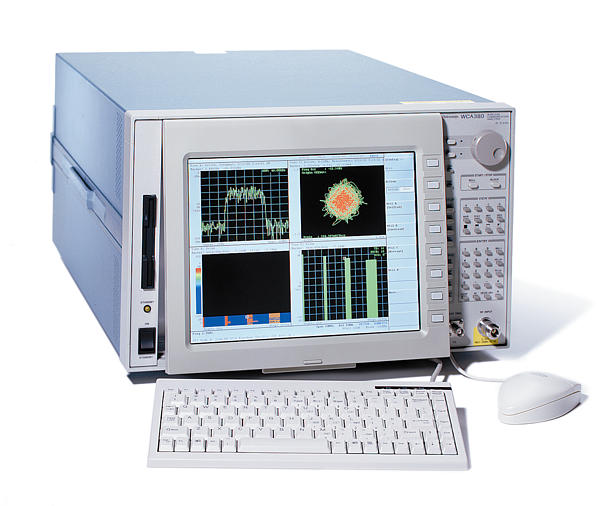Tektronix WCA330 Communication Analyzers

Follow us for the latest equipment specials.
Refurbished Tektronix WCA330

Sell Equipment Repairs Add to cart E-mail this page Alert me when this goes on sale
Tektronix WCA330 Details
Tektronix WCA330
Features & Benefits
- DC to 8 GHz Coverage - Seamless Capture up to 30 MHz BW
- 65 dB ACLR Measurement (3GPP)
- Code Domain Power and Complementary Cumulative Distribution Function (CCDF) for IS-95, 3GPP (3GPP Release 99) Signals
- Analyzes in Frequency, Time and Modulation Domains
- Seamless Acquisition for Capture of Short Duration or Intermittent Events
- Frequency Event Trigger for Acquisition of Burst or Infrequently Occurring Signals
- Post Capture 1000:1 Zoom Allows Analysis of Individual Signals After Wideband Capture
- Support Demodulation - GFSK, BPSK, QPSK, DQPSK, 8PSK, OQPSK, 16QAM, 64QAM, 256QAM, GMSK
- CCDF for Multi-carrier and 3GPP Signals
Applications
- 2nd, and 3rd Generation Cellular/PCS R&D - Including GSM, IS-95, T-53, IS-136, PDC, 3GPP
- Wireless Access Equipment R&D - Bluetooth
- Signature Analysis
- Spectrum Monitoring (Interference and Multipath Fading)
- Setting Time Measurements for Oscillators and Synthesizers
- Capture and Analyze an Unknown Signal
- Debugging of Hardware and Failure analysis of BTS and MS
Voice mobile communication has already transitioned from analog to digital, and is now transitioning to include high-speed data transmission. Given these kinds of changes, the challenges facing engineers are signals that are wider in bandwidth, higher in complexity for modulation and coding, and at ever increasing frequencies.
The measurement needs for the research and development of products that utilize these new technologies and standards for communication links are not all met by traditional sweeping spectrum analyzers and vector signal analyzers. New measurement tools are needed to deal with these new signals. Analyzers that can look over relatively long periods of time, in several measurement parameters and domains, are necessary to prove performance, as well as troubleshoot design shortcomings and problems.
The Wireless Communication Analyzers, WCA330 and WCA380, are designed to satisfy these requirements, and have the features of traditional high performance swept spectrum analyzers and modulation analyzers. They add much more in new capabilities such as real time seamless capture. The captured data is available for time studies of spectrum, digital modulation, and analog modulation, as well as transient artifacts. They also have real time trigger capabilities in the frequency and time domains, which not only make capture possible, but also convenient.
The WCA330 (DC to 3 GHz) and WCA380 (DC to 8 GHz) are based on real-time spectrum analyzers that allow the seamless capture of signal with spans up to 30 MHz. The ability to measure burst signals and infrequently occurring signals, such as those from GSM, IS-136, PDC or IS-95 over a continuous block of time and span of frequencies and RACH signal of mobile station, allows the user to evaluate significantly more information than traditional sweeping spectrum analyzers.
Because of the real time capture of data, the post processing capabilities of the WCA enables the user to look at measurements such as Code Domain Power vs. Time, EVM vs. Symbol at each code, CCDF and Transient Spurious. Because the instrument samples these full frames constantly (rather than waiting for each discrete frequency step to be measured), the signal can come or go as it pleases and the real-time spectrum analyzer will detect the change instantly.
The 12.1 in. color TFT display allows easy viewing of spectrum, waterfall displays, spectrograms and digital modulation analysis screens. Constellation and vector diagrams can be displayed, as well as frequency, phase, magnitude, I and Q versus time, for in-depth analysis of digitally modulated signals. Users can move a marker through the time record and analyze the modulation at any point. In particular, signals with symbol rates up to 20.48 Msymbols/sec may be analyzed during and after capture.
In addition, a frequency mask trigger allows capture of randomly occurring or infrequent signals such as intermittent spurious emissions. If the user is not interested in the period between transmission bursts, the frequency mask trigger allows capture of the "burst-on" period, thus maximizing the number of bursts that can be captured in memory for subsequent spectral, time or modulation analysis.
The user can graphically define the frequency trigger mask; this allows the trigger condition to be generated by a particular event in the frequency domain irrespective of other activity within the displayed span. This is a major benefit when the trigger condition is used to capture signals arising from intermittent spurious or spectral re-growth events.
Options:
1R - Rackmount kit.
C3 - Service, 3 years of calibration services (initial certification and 2 calibrations).
D1 - Calibration data report.
D3 - Service, test data (requires Opt. C3).
R3 - Repair warranty, extended to cover 3 years.
SL7PCW3 - Software: Display and analysis for PC.
A1 - Power Cord, European.
A2 - Power Cord, United Kingdom.
A3 - Power Cord, Australia.
A4 - Power Cord, USA.
A5 - Power Cord, Switzerland.
C3 - Calibration Service 3 Years.
C5 - Calibration Service 5 Years.
D1 - Calibration Data Report.
D3 - Calibration Data Report 3 Years (with Opt. C3).
D5 - Calibration Data Report 5 Years (with Opt. C5).
R3 - Repair Service 3 Years.
R5 - Repair Service 5 Years.




